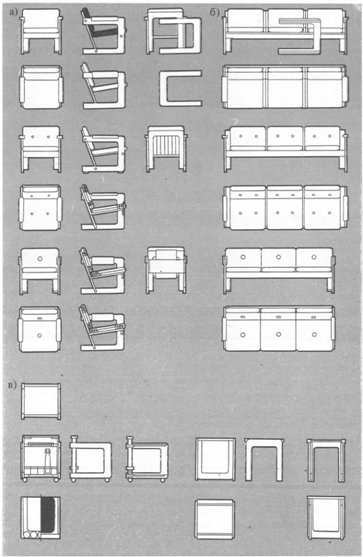
Trends in the artistic design of furniture are largely determined by the state of production and the materials used. Thus, the use of particleboard determines the planar nature of the furniture, the shape of the vertical supports, which depends on the strength characteristics of the plate. A variety of decorative films for cladding chipboard contributes to the development of trends decorative approach to the solution of external, front surfaces of furniture. Synthetic veneer is widely used. It is a decorative film based on resin-impregnated textural and colored papers, wood-based panels with printed wood texture and colored fibreboard.
Recently, a profiled ornament made from alloys of non-ferrous metals and new types of improved face fittings have also been used. The sculptural ornament molded from plastics is also developing. The use of expanded polystyrene for the manufacture of frames of chairs and sofas allows you to create comfortable products of any shape and various forms.
The trends in the artistic solution of modern household furniture can be traced with examples of sets shown at the Third All-Union competition for the best samples of mass production of furniture for new types of apartments, held in 1974-1975. in Moscow on VDNH USSR.
The Relief set is included in the System-10 series of sets, which also includes a set of cabinet furniture for the Jubilee working room (office), for the Autumn bedroom, for the hallway and a room for one or two people. The authors of the series sought to give artistic expression and originality to each set. They used various compositional techniques and decorative means in accordance with the industrial method of furniture production. The overall compositional structure of the Relief set is based on the vertical direction of the divisions. The color solution is based on a combination of wood-tinted black doors and front walls of boxes with white nitro-enamel interior surfaces. Such a reception creates the impression of festive elation. This also contributes to the layouts of profiled duralumin, anodized in bronze color, placed on the front surfaces of the doors and front walls of the drawers, and the front fittings. The section with a bar, on the hinged doors of which applied overhead embossed decorative elements from rigid polyurethane foam or solid wood, is a kind of composite center of the whole set.
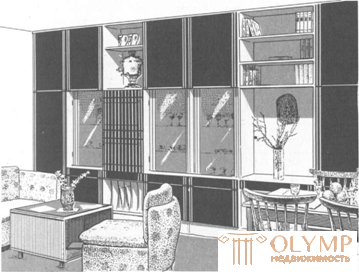
Fig. 1. A set of cabinet furniture for the general room “Relief”, developed by VKPTIM (the head of the group of authors Yu.V. Sluchevsky)
The Caravel set was also developed by VPKTIM (project BN-232-01, head of the group of authors A. Shevchenko). The basis of the set is a constructive scheme with a spatial structure characterized by closed and open volumetric forms in combination with linear and planar elements. The composite center in various variants of blocking sections is a square sliding door of 900X900 mm in size with a 700 mm round glass inserted into it, behind which is a container with removable glass shelves and a mirrored rear-200
A wall with an internal artificial light (fluorescent lamp). The project provides for the execution of a square sliding door in several versions: with round glass, with a blind shield decorated with incrustation (imitation by typographical method), carving, rigid polyurethane foam, imitation imitation leather, i.e. the use of decorative elements based on their industrial method production. By replacing the door, the artistic expression of the whole composition is changed; each variant acquires its own emotional coloring.
The compositional solution of the set is based on the horizontal orientation of the facade, which is achieved by a horizontal row of hinged doors framed by niches and recessed relative to the main planes of the facade, two horizontal belts framing the middle tier, and selected layouts from anodized aluminum. The lower horizontal belt is formed by a series of drawers, and behind the upper belt there is a backlight (fluorescent lamp) and a transparent (glass) shelf. The lighting in the set creates additional comfort and is successfully found expressive artistic means.
The architectural and artistic composition of the “Sunrise” set (Fig. 2) is built on a vertical partition of the facade and the introduction of corner elements enriching the appearance of the furniture and increasing the possibilities of its arrangement. Vertical interpretation of the facade subordinate profile layouts, which are both constructive and decorative elements, the shape of handles, emphasizing the vertical division of the facade surfaces. Enriched by a set of concave and convex smoked glass doors in the corner products.
A set of furniture for common rooms. “Kamerton” was also developed by the design office of furniture design MMSK-1 (the head of the author group S. A. Selivanov). In it, the leading compositional theme is the identification of vertical divisions formed by dark plates. The strict structure of the facade surfaces is softened by the horizontal niches of the open shelves. A simple architectural form corresponds to the decoration of the set. The doors, front walls of the drawers are lined with a synthetic film imitating the texture of bleached birch. The figured handles are made of dark mahogany.
Set B-2075-12 was developed by an experimental furniture design and technology bureau of the Minsk Design and Industrial Furniture Association of the Minlesprom of the Byelorussian SSR (head of the group of authors BF Kurlischuk). At the heart of the architectural and artistic construction of a series of cabinets is a 400 mm module, which is well combined with the planning solutions of modern apartments of mass construction. Cabinets have the necessary functional compartments for clothes, books, dishes, dresses and other household items; offices with a bar, a secretary are distinguished by good proportions and expressiveness of the drawings due to the decorative elements and the color scheme of the cladding and decoration. Shield elements are lined with oak veneer and veneered with preserving the natural color of wood and obtaining a matte finish.
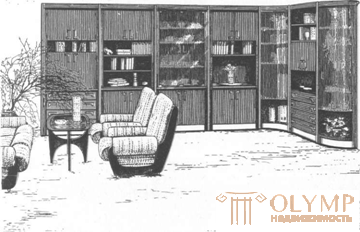
Fig. 2. A set of furniture for the general room “Voskhod”, developed by KBPM MMSK-1 of the Ministry of Industry and Industry of the USSR
The set B-2296 was also developed by an experimental design and technical office of furniture of the Minsk design-and-production furniture association (head of the group of authors N.V. Makarevich). The composition of cabinets is based on a strong identification of vertical divisions. The set has a large variation, proportionality and expressiveness of the pattern due to the use of decorative elements, various color solutions and a variety of veneering and finishing options. Glass swing doors are hinged on vertical bars instead of the usual frames.
The third prizes at the competition were marked by the sets "Ron", "Rock" and "Comfort".
The set of "Ron" was developed by the furniture experimental factory "Standard" of the Ministry of Industry of the Estonian SSR (the head of the group of authors P.G. Lyun). It is designed sectional design and can be used for the equipment of the general room, living room, bedroom, nursery, working room (office), hallway. Products are faced with planed veneer from hardwood and are lacquered with pre-dyeing and obtaining a matte finish. The set is characterized by some fragmentation of divisions and due to the smaller scale.
The Scala set was also developed by the Standard furniture experimental furniture factory (head of the group of authors M. L. Grinberg). It is lined with oak veneer and veneered with pre-dyeing in black and obtaining a matte finish. With favorable utilitarian qualities, the set, thanks to the proportions of the elements, as well as the color scheme, creates a neutral surface that fits well with the interior of a modern apartment.
The Comfort set was developed by VPKTIM (project IB-1379, the head of the group of authors N.V. Tikhonova). A distinctive artistic feature of the set is the plasticity of the facade, which is achieved through the use of flush compartments, decorated with light enamel, and protruding pylons supporting the mezzanine part and revetted with veneered veneer. Depth sections hitting the depth of the compartments are equipped with glass and plastic hinged doors in the upper and middle tiers with relief. Due to the excessive number of artistic means (plastic design of the facade, decorative glass, new veneering materials), the unity of the composition is not sufficiently pronounced in the kit.
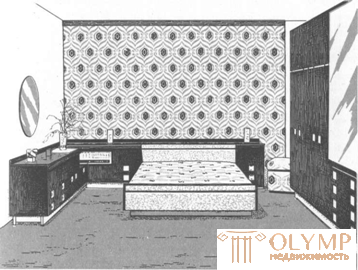
Fig. 3. A set of “Sonata” for the bedroom, developed by KBPM MMCK-1 (the head of the group of authors S.A. Selivanov)
The “Sonata” set (fig. 3) is distinguished by its compactness and individuality. It provides night lamps mounted in the niches of the bedside tables. Large mirror doors of the cabinet fit well into the interior of the bedroom and are convenient in function. A loosely hanging round mirror complements the equipment and the decoration of the bedroom, in the composition of which horizontal divisions prevail.
The Birch set was designed by the furniture design center of MMSK-1 (S.A. Selivanov, head of the author group). It is of interest to have a bedside unit with a common horizontal niche where the combined lighting is mounted: fluorescent lamps for working lighting and a low-power incandescent lamp as decorative lighting or instead of ordinary night lamps. Constructive horizontal division of the bedside unit is well combined with a low bed. Noting the successful artistic solution of the set, one should, however, pay attention to the excessive granularity and multi-darkness of the headboard.
The series of bedroom furniture sets was developed by the furniture design bureau of the Minmebelprom of the Lithuanian SSR (project 792, the head of the group of authors L. A. Stapulenien). It includes a group of cabinets (four options in height and two in width) for various purposes, six options for beds, four options for mirrors and stools. The advantage of the series is the high unification of the elements of the products, their comfort, the wide possibility of assembling completely different in appearance and composition sets!
The products of the first variant are distinguished by the original, beautifully traced shape of the head-back of the bed and the frame of the mirror. The framing decorative board upholstered with an imitation leather connects a product in a single whole. The same material is applied on the doors of the cabinets, the front walls of the drawers and framing the sides of the bed, and the pouf. Set settled in soothing, exquisitely sustained colors. Tapestry, imitation leather and planed mahogany veneer blend well in color.
The products of the second variant are harmoniously connected into a single whole due to the successfully chosen compositional technique — the visual combination of the bed with low toilet cabinets installed on its sides with mirrors, a chest of drawers, a wardrobe for linen and two puffs.
The upholstery fabric, which covers not only the bed of the bed and the seat of the poufs, but also the front surfaces of the cabinet products (doors and front walls of the drawer cabinets), is very decorative. The product range makes it possible to equip a bedroom of any size by arranging the front of various products that have a single architectural, artistic, and constructive technological solution. The number of composite set options increases with the use of products with different finishes. Beds, stools and frame mirrors can be covered with fabric, artificial leather or artificial leather with tapestry; cabinets can be lined with sliced veneer or its substitutes with surface coating with nitrocellulose and polyester varnishes, as well as enamels. The drawers and doors of the cabinets can be lined with fabric or artificial leather with plastic edging in combination with the finishing of other surfaces of the cabinets with enamels and varnishes.
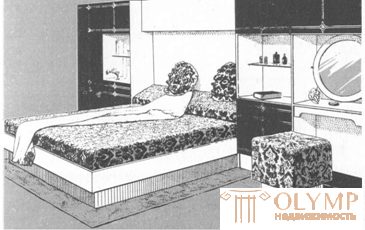
Fig. 4. A set of “Osan” for the bedroom designed by VKPTIM (the head of the group of authors Yu.V. Sluchvasny)
The shape and design of beds and poufs are successful. The soft board framing them around the perimeter gives particular completeness to the form, connecting them into a single whole, expands the possibility of composite and finishing solutions.
The Autumn set (fig. 4) consists of a group of cabinets forming a wall and a bedside sectional block of multifunctional use with a double bed. The doors and front walls of the cabinets are lined with artificial leather, on the surface of which a decorative pattern is applied by embossing. Quiet harmony is created thanks to the white color of the coatings of the internal volumes of the sections and the bed frame in combination with the soft texture of artificial leather on the front planes of the products and the muffled tone of the bedspreads and bed pillows.

Fig. 5. Diagram of the products of the “Necklace” set developed by VKTIM (the head of the group of authors A. Shevchenko): a - bedside tables; b - cabinets; In the bed; g - options for bedside tables
In the “Necklace” set for the bedroom (fig. 5), the main volume of the room is occupied by cabinet furniture and beds. For decorative qualities, these products in the formation of the interior space have a dominant role. The composition of the set is built on the opposition of laconic forms and the solid plane of the doors of the cabinets for the dress and linen to the more complicated elements of the bedside unit. The combination of a horizontally oriented bedside unit with emphatically vertical cabinets (creates a contrasting composition to the whole height (room). The feature of the set is a relatively high baseboard box (200 mm) that visually unites all objects. The architectural and artistic feature of the set is the decorative insert planes on the front surfaces ash wood with a golden moire texture, framed in anodized aluminum (or plastic imitating wood) layouts. Soft with Despite the expressiveness of the overall compositional solution, you can still notice some congestion with decorative tools (layouts, two-color, pattern of the finish of the front surfaces, a different form of niches), which creates a spatially unjustified visual activity of the products. .
The first award among the sets of cabinet furniture for a room for one or two people (a teenager, a child, an adult family member) was awarded a set of “Credo” (Fig. 6), designed to equip rooms for young people and teenagers or special functional areas (work, sleeping places) in the common rooms of residential apartments. A feature of the set arrangement is the ability to create a specific environment, a figurative, rationally organized interior with different variants of space-spatial divisions for individual functional areas, as well as the use of podium beds as a playing area at an additional level. Two levels of the playing field (the plane of the floor and the plane of the beds-podiums) are lined with one color material, which contributes to the creation of special psychological and architectural-spatial connections in the interior. The decoration and the method of decorating furniture products are due to the fact that the general character of the room (for children, youth) creates not only furniture, but also things and objects necessary for the student and the student. Cabinet furniture products have a pronounced vertical structure and are neutral in decoration.
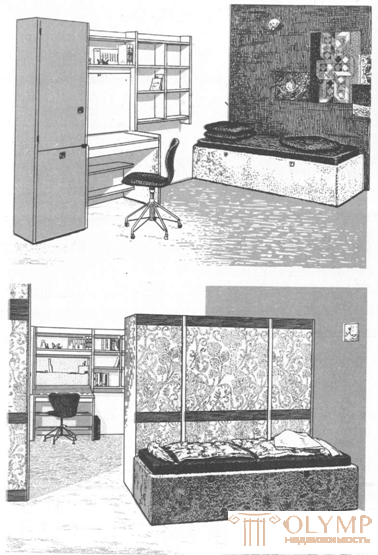
Fig. 6. A set of "Credo" for a room for one or two people, developed by VKTIM (the leaders of the author's group B. A. Vasiliev, L. A. Portnoy)
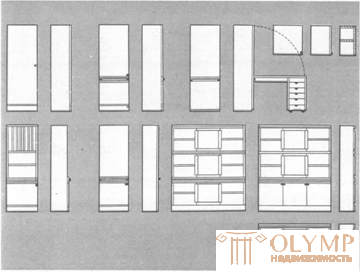
Fig. 7. Scheme of the products of the Penguin case furniture set for the equipment of the working room (office designed by VKTIM (head of the group of authors A. Shevchenko)
Among the sets of cabinet furniture for the working room (office), the “Jubilee” set developed by VKPTIM (the head of the group of authors Yu.V. Sluchevsky) was marked. The set is solved in the form of lockable universal prefabricated and sectional cabinets, located in a line or at an angle. Products included in the set are distinguished by ease of proportions, stylistic unity. The front surfaces of the doors are decorated with silhouette patterns in rectangular frames. In the section that plays an accentuating role in the composition of the set, plot images based on illustrations for the novel by A. S. Pushkin “Eugene Onegin” are applied.
Поощрительной премией был отмечен набор «Пингвин» (рис. 7), архитектурно-художественной особенностью которого являются раздвижные стекла с вертикальными деревянными ручками, окантованными раскладками из анодированного алюминия и служащими рамами для декоративных вставок (эстампов, фотографий, гравюр, тканей и т. д.). Композиционной особенностью набора можно считать сочетание сдержанного характера спокойных прямоугольных плоскостей фасадов закрытых отделений с ярко выраженной осью стеклянных дверей и открытых ниш.

Fig. 8. Серия стульев «Квинта-1»
На конкурс были представлены серии стульев. Первой премии удостоена серия Б-2000, Б-20000-01, Б-20000-02, разработанная экспериментальным конструкторско-технологическим бюро мебели Минского проектно-производственного мебельного объединения (руководитель авторской группы Б. Ф. Курлищук) и предназначенная для оборудования служебных и жилых помещений. Стулья, входящие в серию, отличаются выразительной и лаконичной формой, легкостью пропорций.
Второй премией были отмечены серии стульев «Квинта-1» (рис. 8) и «Квинта-2», разработанные Московским высшим художественно-промышленным училищем (МВХПУ, бывш. Строгановское; руководитель авторской группе! В. А. Голубев) и предназначенные для жилых квартир массового строительства. Все модели стульев этих серий отличаются простотой. Их конструктивно-архитектурной особенностью являются плоскоклееные боковины, изготовленные из лущеного шпона с последующей обгонкой по шаблону на фрезерных станках. Сиденья и вертикальные элементы спинок изготовлены из фанеры, царги и горизонтальный элемент спинки — из массива древесины твердых лиственных пород. Стулья отделаны укрыви-стыми красителями. Предусмотренный автором различный цвет обивочных тканей, окраски и отделки каркасов, а также разнообразие конструкций спинок позволяют получить большое число вариантов внешнего вида стульев в каждой серии.
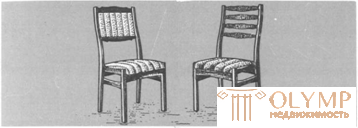
Fig. 9. Серия стульев «Вента»
Второй премией отмечена также серия стульев «Вента» (рис. 9), разработанная проектно-конструкторским бюро мебели Минмебельдревпрома Литовской ССР (руководитель авторской группы Б. М. Адомонене). Стулья имеют деревянный (из твердых лиственных пород) каркас из элементов прямоугольного сечения. Сиденья и заглушина спинки обтянуты гобеленом с рельефной декоративной строчкой. Художественной особенностью моделей является спинка (модель 825-01) в виде поперечин и рельефных вертикальных выемок на ножках и боковинах спинок.
The 824 series, which won the second prize, includes semi-soft and hard chairs with flooring (Fig. 10) for universal use in homes and institutions. Hard chairs have three options with the same frame and seat, but with different backs on the pattern. The seat and back are covered with tapestry with decorative embossed stitching.
The first prize among the sets of upholstered furniture for rest was awarded the Tulip set. The set was developed by the design center of furniture ММSK-1 (V. A. Selivanov, the head of the author group). The set includes four items: a sofa, two armchairs and a pre-table. The compositional solution of products is based on an unusual combination of round-shaped soft pillows with light glued sidewalls. With a large degree of softness, the armchair and sofa do not cause cumbersome impressions, and the presence of ball bearings ensures their easy movement on the floor. The color and texture of the well-chosen fabric in combination with the velvety matt finish of the wooden elements, the plastic of the pillows and the armrests emphasize the individuality of the decision. Acknowledging the positive aesthetic qualities of the set, one cannot fail to mention the overly elaborate form of the carrying part of the predivided table.
Оригинально решение мягкой мебели в наборе «Пан» (вторая премия), разработанной мебельной экспериментальной фабрикой «Стандарт» Минлеспрома Эстонской ССР (руководитель авторской группы М. Л. Гринберг). Набор состоит из мягких модульных элементов, обтянутых мебельной тканью, на базе которых можно составить кресло для отдыха, одно-, двух-, трех-, четырехместные и угловые диваны и создать большое число планировочных вариантов при оборудовании общей комнаты мягкой мебелью. Ритм сложных по форме мягких элементов хорошо сочетается с характером решения корпусной мебели, подчеркивая ее изящные пропорции. Элементом, осуществляющим зрительное единство мягкой и корпусной мебели, является преддиванный стол, решенный несколько необычно. Четыре тумбы, выкатывающиеся из-под крышки, значительно увеличивают число посадочных мест и обеспечивают дополнительный комфорт и разнообразие при пользовании изделием. Тумбы служат для посуды и столовых принадлежностей; для радиоприемника, магнитофона или проигрывателя; для фонотеки и газет; тумба-бар с глубоким отделением — для бутылок и мелким отделением для бокалов. Все тумбы установлены на шаровых опорах.
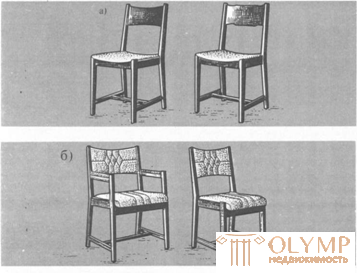
Fig. 11. Серия стульев 824, разработанная ПКБМ Минмебельдревпрома Литовской ССР (руководитель авторской группы Л. В. Завецкене) а — с жесткими спинками; б — с мягкими спинками
Третьей премией среди наборов мягкой мебели отмечен набор «Салазки» (рис. 12), в основу которого положена конструктивная схема с открытой пространственной структурой, где преобладают линейные формы и сочетание линейных форм с плоскостными. В качестве конструкционных и формообразующих деталей использован П-образный плоскоклееный из шпона элемент. Собирая с его помощью кресла, диван, преддиван-ные столы, можно получить изделия лаконичной формы с выразительным силуэтом; при этом виден чистый технологический прием, не скрытый декором.
Набор «Мираж» (рис. 13) служит для оборудования зоны отдыха с различными функциями: отдыха, приема гостей, чтения и т. д., обладает большими художественными достоинствами: лаконичностью формы, крупным масштабом, подчеркну-тостью доминирующей горизонтали.
The “Tapestry” set (fig. 100) is intended for equipment of any area of the hall with the minimum and maximum use of products. A feature of the set is the vertical division of cabinets by narrow pilasters, to which the doors are attached. The color solution includes pilasters of cabinets and a frame-mirror of the same color. For finishing the hallway, including the front surfaces of products, a synthetic self-adhesive film is used (artificial leather, synthetic veneer, enamel can be used), which makes it possible to renew the interior of the hallway, since the film is easily replaced at home. So that the products do not visually clutter up the space, the same material is used or the material of the same color is used to finish the doors of the cabinets and hallway walls.
Trends in the artistic decision of furniture depend on the trends in everyday processes. The expansion of the functions of the apartment makes a different approach to the functional purpose of its individual premises and their equipment. The tendency to view an apartment as a complex organism that meets not only utilitarian, but also growing spiritual needs of a person, is increasing, which is largely determined by the increase in free time due to shorter working hours and the alleviation of many labor-intensive everyday processes, as well as an increase in cultural level. population. Free space and its multifunctional use are becoming increasingly important. Hence the spread of cleaned and transformable furniture, mobile and folding partitions, mobile equipment items.

Fig. 12. Diagram of the set of upholstered furniture “Sled”, developed by ZPKTIM (head of the author group A. M. Shevchenko) '. a - chairs; b - sofas; in - pre-sofa tables
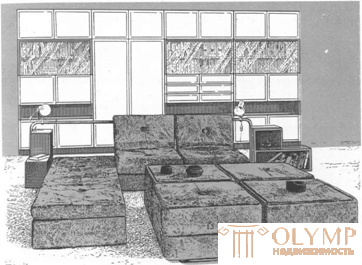
Fig. 13. A set of upholstered furniture for rest with the Mirage predivided table developed by the furniture experimental factory “Standard” of the Ministry of Industry of the Estonian SSR (the head of the group of authors M. L. Grinberg)
The complex interweaving of the model based on the detection of the universal in the household processes (cooking and eating, sleeping, personal hygiene, cleaning the rooms) and the individual related to differences in the human needs and his attitude to household typing environment, which in turn depends on a number of social factors (cultural level, artistic taste, fashion, etc.).

Fig. 14. The Tapestry Set, developed by VPKTIM (head of the group of authors E.P. Fomin)
Having considered a number of techniques for solving major groups of household furniture, presented at the Third All-Union Competition, we can note new trends in its artistic solutions.
For the common room of a modern apartment is characterized by complex multifunctional use. Being the main place for family communication, it at the same time often becomes a study room, as well as a youth and children's room, one family member can sleep in it, etc. The variety of functional processes in the common room and the desire to individualize the home cause a steady trend. to develop not complexes, but functional groups of furniture, from which the buyer chooses the products he needs. Therefore, for the last competition for the best samples of furniture, furniture groups were developed, rather than complete sets.
The tendency of individualization of the home was particularly evident in the MEBAR product system (incentive bonus), which is based on the principle of self-design of the home by the inhabitant himself (Fig. 15). The equipment of the common room includes three main functional groups of furniture: cabinet (wall), furniture for rest, furniture for eating areas.
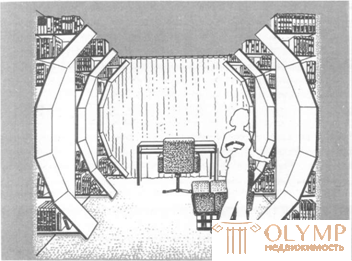
Fig. 15. The system of furniture equipment MEBAR (the authors of the project I. I. Luchkov, A. V. Sekachev, TSNIIEP dwelling
The group of cabinet furniture (wall) is most significant in the spatial and substantive organization of the common room. Noting the still developing direction of the neutral solution of cabinet furniture for common rooms, one can still mention some of the characteristic features of the samples shown at the Third All-Union Competition. The multifunctional purpose of the wall, its saturation with various equipment and devices has the effect of complicating the internal structure and composition: alternating open and closed tiers (Kamerton sets, NM-78), introducing different-sized similar elements (such as, for example, doors in set 833 ), free placement of open niches, etc. The plastic of body products is enriched by introducing different-sized niches, highlighting them with color.
Analyzing the sets of cabinet furniture for common rooms, it should also be noted the growing desire to emphasize and identify vertical divisions (set “Way”), to saturate facial surfaces with decorative means made by various artistic and technical methods: wood carving (genuine and imitative). ), pasting with a film with an ornament, etc. Competitive furniture is characterized by the active use of new decoration and facing materials, the abandonment of mandatory wood-texture surfaces her products. To the previously known opaque coloring, pasting with a synthetic film was added the use of the leather substitute and decorative fabric as a lining for the shield elements. The front fittings are given a decorative sound. One set combines various design techniques for solving similar functional elements (for example, panel and hinged doors) to single out one of them. Lighting is used as a means of artistic expression.
In order to achieve diversity and individual character of products of similar functional purpose, one should, however, avoid fragmentation of the main divisions, making the group of cabinet furniture in the common room less neutral, more active in the interior, which often leads to a contradiction with the main task of modern furniture - to be an organizer of space. An actively developed group of cabinet furniture may lose its background character and will cease to contribute to the impression of a freer space of the room, may become annoying with long-term use.
Modern upholstered furniture becomes more sculptural, saturated with plasticity, enriched with color and finishing materials. The main trend of its solution is a high degree of compositional mobility and transformation. Modern upholstered furniture plays the role of a factor actively organizing the space of the room, which was especially vividly demonstrated by the designers of the Lithuanian SSR in sets of 809 and 840, awarded second prizes. In these sets, the principle of transformation has moved to a different scale. It is no longer a product that is transformed, but a whole spatial system of products, there is a need to transform the interior both compositionally and psychologically, having allocated a recreation area in the common room. In the same character, the Pan and Mirage kits are solved, allowing to create various composite solutions.
The principle of carpentry design chairs gives way to sculptural, the frame is formed by spatial bearing elements of plastic materials, fully covered with cloth. Hence the increasing role of fabrics and the new attitude towards their artistic characteristics.
At the same time, the traditional approach to the solution of upholstered furniture continues, which can be characterized by the search for more comfortable solutions, as well as solutions that create the unity of the artistic appearance of the interior as a whole. One such example is the Tulip kit developed by KBPM MMSK-1. The chairs which are included in the package differ in good proportions, a harmonious ratio of soft and joiner's elements.
In modern domestic practice, noticeably increased attention to furniture for the equipment of bedrooms. Here, along with a thorough decision of the purely utilitarian side of furniture products (for example, working out containers for storing various household utensils, etc.), a search is under way for a variety of individual artistic solutions. The general compositional reception of sets of furniture for bedrooms is the opposition of the vertical plane of the hull products and the horizontal of the sleeping places.
The vertical construction of the cabinets is visually supported by the decor of the front surfaces of the doors. There is a noticeable tendency of the developed solution of the bedside unit, which includes open niches of various shapes, various closed compartments, etc., enriching the plastics of furniture products.
Mirrors and decorative elements are included in the bedside units. The headboard in the bedroom has become the main element, which is given the character of artistic expression. Particularly favorable results are obtained when, without overloading with additional volumes, an expressive, plastic form (set 792) is reported to the head of the bed. Recently, the trend of using a wider range of finishing materials has also increased. This is especially pronounced in the furniture for bedrooms. Here, along with traditional materials, upholstery fabrics and artificial leather are widely used, which makes it possible to make the forms of furniture products more plastic, and to give the furniture itself a warmer, more comfortable character. The role of the ornamental decoration of the bed of the berth has increased. Often a material with the same pattern is used to finish the front surfaces of the headboard, hull elements, even one of the walls. This technique has many advantages, since it helps to combine all the equipment of the bedroom and gives the impression of more free space, which is especially important for small bedrooms.
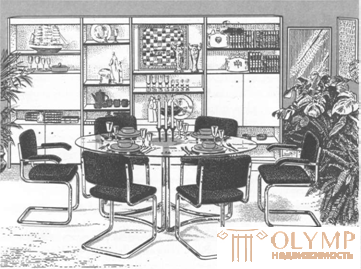
Fig. 16. Identification of the vertical structure of furniture (foreign practice)
The leading trend in the artistic solution of sets of furniture for the room of a teenager or a child is the variability of elements, the possibility of their significant combination, as well as the wide use of color, especially light and bright colors. An important feature of furniture for young people is to provide the consumer with the possibility of the final artistic solution to the interior.
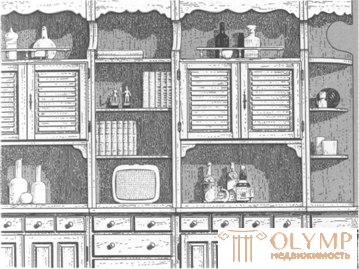
Fig. 17. Use of traditional forms in cabinet furniture (foreign practice)
In sets of cabinet furniture for cabinets, there is a tendency towards the traditional solution of cabinets with closed compartments, accentuated vertical construction, the introduction of decorative elements, even of a pictorial character. As a positive trend, it is possible to regard the inclusion in the product of structural elements for the placement of decorative inserts.
In addition to the utilitarian side, the sets of cabinet furniture for the hallway clearly revealed the desire of the authors to find the individual character of the products, as well as to achieve unity of composition. In this respect, the “Tapestry” set is indicative, in which, thanks to the use of a single material for the finishing of the doors of the cupboards and hallway walls, the effect of complete visual emptying of the room is achieved.
As the competition showed, the design of furniture for kitchens in our country continues to follow the path of strict compliance with the conditions of utilitarian use.
Identifying trends in the artistic solution of modern furniture on the example of samples from the Third All-Union Competition, we can note a significant increase in the professional skills of designers who create comfortable and beautiful dwellings of mass construction and own the entire arsenal of artistic means of modern furniture.
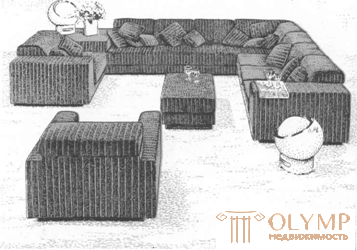
Fig. 18. A group of upholstered furniture, formed with the help of modular elements.
In order to develop the future direction of furniture design and search for new expressive artistic solutions, it is useful to familiarize yourself with the main trends in furniture design abroad.
In cabinet furniture, the identification of vertical divisions is often noticeable through the use of various materials, for example, metal lining of vertical posts. Color finishing of cabinet furniture products with a predominance of light and bright colors, local colors is widely used. In cabinet furniture often used traditional or traditional forms. For cabinet furniture of various purposes, the tendency of the variable solution of products remains in force. The principle of using modular units to achieve a variety of planning combinations is increasingly being used to solve a group of upholstered furniture. For the products of this furniture is characterized by the rhythm of construction, often combined with increased plastic expressiveness. Sofas, assembled from modular soft elements, have backrests of complex plastic shape. Speaking of upholstered furniture, mention should be made of the distribution of coiled structures. The soft elements of the furniture are diversified by stitching various patterns, introducing fastening belts, buckles, which have a certain decorative sense. When coiled designs, upholstery materials are of particular importance: leather, materials with a soft texture (plush-shi), upholstery fabrics. Along with smooth upholstery materials of various textures and colors (often very intense), patterned fabrics with various patterns are also used: geometric, vegetable, etc. One may note a tendency towards enlargement of the scale of the upholstery fabrics used for upholstered furniture. The use of a single fabric for upholstered furniture and curtains is quite common, which is especially favorable for small rooms, since it contributes to the impression of a single space.

Fig. 19. An example of the use of transparent materials in the table cover and the supporting elements of the stools

Fig. 20. An example of household furniture with opaque finishing of front surfaces: a - mobile furniture; b - fixed furniture
In the design of furniture abroad, there is a strong tendency to dematerialize the form: the use of transparent materials (Fig. 19), mirrors in the interior decoration, the spread of a cold gamut. Chairs are ingeniously dealt with, where the opaque elements are only the seats and the finish of the edge of the back, which passes into the elbows. In general, the introduction of new, previously unused materials, including metal, into the design of household furniture is characteristic of modern foreign practice. For example, common rooms are equipped with dining tables and chairs on metal frames, which are well combined with the warm texture of wood cabinet furniture. Furniture with opaque decoration (Fig. 20) is also widely used.
Along with the furniture, which is solved in modern forms, furniture that can be called imitation furniture is spreading abroad, as it is an imitation of furniture of the past styles or of folk furniture. Such furniture is available in limited quantities. The interiors created by progressive architects are equipped with furniture that can be solved in a variety of modern forms.
Being one of the main premises of the dwelling, the kitchen remains in the center of attention of foreign architects and designers. Tracing the development of kitchen equipment, we can note the intensified tendency of its diverse solution not only in a narrowly utilitarian respect, but also as a room for a day stay of a family in which there is a place for children to play, which is convenient for the mother working in the kitchen, and also a workplace for whom - from family members. The desire to make the kitchen a room with universal use was reflected in its design, equipment and furniture. In addition to the tendency to increase its size, there is a clear desire to link it directly to residential premises. The improvement of the utilitarian side of the device, which is manifested in the rationality of the layout of the rooms and the use of new, sophisticated equipment, goes hand in hand with the search for new, original artistic techniques for solving the interior of the kitchen.
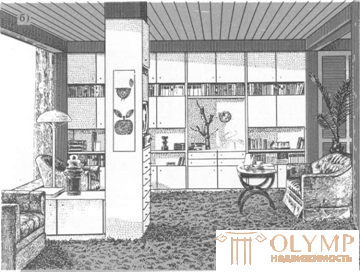
Fig. 21. An example of creating a visual unity of the interior of a common room and kitchen
There are fewer examples of kitchen labs. Various techniques of planning and visual communication of the kitchen with the common room are spread (Fig. 21). In some cases, it is a device for openings with different artistic characteristics of the premises, in others - the use of tools that contribute to the visual integration of the two rooms into a common space. Used, for example, the introduction of a single intense bright green color to finish the ceiling and table cover, which is also a place for eating and serving to embed the plate and sink.
An additional tool that helps to combine the two spaces is the introduction of wicker chairs in the kitchen and the placement of a collection of baskets and wicker boxes on the open shelves of cabinets in the common room.
In foreign practice, examples of island kitchens are widely represented. Середину помещения занимает прямоугольный в плане блок, включающий плиту и мойку, с одной стороны которых размещена рабочая поверхность, а с другой — крышка обеденного стола. По периметру стен расположены шкафы для хранения столовой и кухонной посуды. Одной из распространенных тенденций в решении интерьера кухни, а также интерьеров помещений другого назначения, является гармоничное объединение старого и нового. Часто современное оборудование (встроенные духовые шкафы, плита, мойка) сочетается с традиционными филенчатыми деревянными дверцами, плиточным терракотовым полом, облицовкой стен, имитирующей дельфтскую плитку. Убранство кухни дополняется старой кухонной утварью: весами, утюгом, керосиновой лампой.
Возросло значение пластики, сочетание разных объемов в кухне, что вызвано утилитарными соображениями и стремлением уйти от монотонности и безликости. Для этого прибегают к подчеркиванию перепадов основных уровней, введению открытых отделений для хранения посуды и утвари.
Прослеживается тенденция признания в убранстве кухни ведущей роли цвета. Часто, особенно при объединении кухни с жилой комнатой, собственно кухонное оборудование выделяется активной окраской в красный, зеленый и другие яркие цвета. Широко применяется также орнаментальная отделка стен над рабочим оборудованием.
Эффективным художественным средством, к которому все более часто прибегают художники при решении убранства кухни, является сочетание и сопоставление фактур современных и традиционных отделочных материалов.
Что бы оставить комментарий войдите
Комментарии (0)